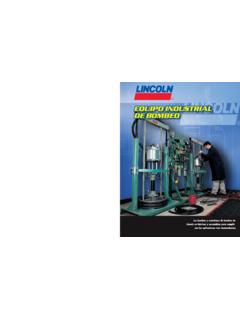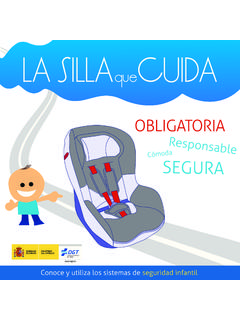Transcription of The UPS Battery Handbook - HM SISTEMAS
1 PowerChain Management solutions The UPS. Battery Handbook Table of Contents Table of contents Battery Four factors that impact Battery Battery Battery maintenance for extended Battery Battery Battery Products and Services from Eaton Extending Battery service Customer Support Battery The UPS Battery Handbook Understanding your UPS Battery can extend Battery life, prevent costly downtime and save time and money It's well understood that the Battery in a UPS is the most vulnerable part of the system. In fact, Battery failure is a leading cause of load loss. Knowing how to maintain and manage your UPS batteries will extend Battery life and save you time and trouble in the future. Improvements in Battery technology have been evolutionary rather than revolutionary. Capabilities such as advanced charging regimens, software management for accurate remaining life information and firmware adding intelligence to the batteries have reduced, but not eliminated, the risks inherent in depending on any Battery .
2 Therefore it is prudent, if not essential, to take a close look at what may be increasing your risk of unexpected load loss from a failing UPS Battery . After all, even large installations with many batteries are vulnerable to the failure of a single Battery . 2 EATON CORPORATION The UPS Battery Handbook UPS Battery overview There are primarily two kinds of batteries used in UPSs valve- VRLA. regulated lead-acid (VRLA) batteries, also known as sealed or maintenance-free, and wet-cell (also called flooded-cell). VRLA VRLA batteries are sealed, usually within polypropylene plastic. batteries usually have lower up-front costs but have a shorter VRLAs were developed because they have the advantage of lifetime than wet-cell, usually around five years. Wet-cell containing no sloshing liquid that might leak or drip out when batteries require more advanced maintenance but have a longer inverted or handled roughly.
3 The term valve-regulated refers to lifetime, up to 20 years. the method of gas release. If the gas pressure becomes too great inside the Battery , the valve will vent when it reaches a certain pressure. Overview During charging of a lead-acid Battery , hydrogen is normally liberated. In a vented Battery , the hydrogen escapes into the atmosphere. In a VRLA Battery the hydrogen recombines with oxygen, so water loss is minimized. Under normal float conditions, virtually all of the hydrogen and oxygen is VRLA batteries are frequently recombined. Re-sealable valves vent non-recombined gases only used in UPS or other high-rate when pressure exceeds a safety threshold. applications. A VRLA Battery is distinguished from a flooded-cell Battery by the rate at which oxygen is evolved from the positive plate and diffused to the negative plate, ultimately forming water.
4 This rate is several orders of magnitude faster than a flooded-cell Battery . Because water cannot be added, recombination of water is critical to the life and health of a VRLA Battery . Any factor that increases the rate of evaporation or water loss reduces the life of the Battery . Such factors can include ambient temperature and heat from the charging current. Positive Flag Extruded Intercell Valve Terminal Welded Connection, Low Resistance Current Path Cover/Lid Strap Joining Negative Plates in Parallel Negative Pasted Plate Lead Alloy Grid Polypropylene Container/Jar Separator Internal and external components of a valve-regulated lead-acid (VRLA) Battery . 3. Wet-cell/flooded-cell Like all batteries, UPS batteries are electrochemical devices. A. UPS uses a lead-acid storage Battery in which the electrodes are Wet-cell/flooded-cell batteries have thick lead-based plates that grids of lead containing lead oxides that change in composition are flooded with an acid electrolyte.
5 This is a highly reliable during charging and discharging, and the electrolyte is dilute design failures normally don't occur until halfway through their sulfuric acid. In other words, they contain components that 20-year pro-rated life, at which time the failure mode is most react with each other to create DC electrical current. These often a short circuit. This situation is not an extreme emergency components include: because any one shorted cell only affects overall reserve time by a very small percentage. However, while they are very reliable E. lectrolyte The medium that provides the ion transport with a long life, there are downsides to wet-cell batteries as well. mechanism between the positive and negative electrodes of a Overview They require more safety measures, and a space-consuming cell; in VRLA batteries the electrolyte is immobilized, while in separate Battery room to use this technology.
6 Flooded-cell batteries it is in liquid form Regardless of the differences in UPS Battery types, they both G. rid A perforated or corrugated lead or lead alloy plate used require monitoring and maintenance to ensure maximum life and as a conductor and support for the active material system availability. Anode The terminal where the current flows in Cathode The terminal where the current flows out V. alve (used in VRLA batteries) Used to vent the build-up of gas that goes beyond pre-determined levels S. eparator A device used for the physical separation and electrical isolation of electrodes of opposing polarities Wet-cell batteries require more Jar The container holding the Battery components advanced maintenance but have a longer Battery service life. Wet cell batteries in a large Battery room application Battery arrangement and power Connecting in series [double voltage, same capacity (ah)].
7 In most UPSs, you do not use just one cell at a time. They are normally grouped together serially to form higher voltages, or in parallel to form higher currents. In a serial arrangement, the +12V. + - + - voltages add up. In a parallel arrangement, the currents add up. 6V 6V. However, batteries are not quite as linear as the two graphics to the right depict. For example, all batteries have a maximum current they can produce a 500 milliamp-hour Battery cannot Connecting in parallel [same voltage, double capacity (ah)]. produce 30,000 milliamps for one second, because there is no way for the Battery 's chemical reactions to happen that quickly. +6V. + +. And at higher current levels, batteries can produce a lot of heat, 6V 6V. which wastes some of their power. - - Series connection Parallel connection Connection of the positive Connecting all the positive terminal of a cell/ Battery to or all the negative poles of the negative terminal of the several batteries increases next cell/ Battery increases the capacity of a Battery the voltage of the Battery network while maintaining network while keeping the a constant voltage.
8 Capacity constant. 4 EATON CORPORATION The UPS Battery Handbook Four factors that impact Battery life Batteries have limited life, usually showing a slow degradation of 4. Maintenance capacity until they reach 80 percent of their initial rating, followed by a comparatively rapid failure. Regardless of how or where a Service and maintenance of the batteries are critical to the UPS is deployed, and regardless of its size, there are four primary reliability of the UPS. A gradual decrease in Battery life can be factors that affect Battery life. These are ambient temperature, monitored and evaluated through voltage checks, load testing Battery chemistry, cycling and service. or monitoring. Periodic preventive maintenance extends Battery string life by preventing loose connections, removing corrosion 1.
9 Ambient temperature and identifying bad batteries before they can affect the rest of the string. The rated capacity of a Battery is based on an ambient temperature of 25 C (77 F). It is important to realize that Even though sealed batteries are sometimes referred to as any variation from this operating temperature can alter the maintenance-free, they still require scheduled maintenance and performance of the Battery and shorten its expected life. To help service. Maintenance-free simply refers to the fact that they do determine Battery life in relation to temperature, remember that not require fluid. for every C (15 F) average annual temperature above 25 C. (77 F), the life of the Battery is reduced by 50 percent. Without regular maintenance, your UPS Battery may experience heat-generating resistance at the terminals, improper loading, 2.
10 Battery chemistry reduced protection and premature failure. With proper maintenance, the end of Battery life can be accurately estimated UPS batteries are electrochemical devices whose ability to store and replacements scheduled without unexpected downtime or and deliver power slowly decreases over time. Even if you follow loss of backup power. all of the guidelines for proper storage, usage and maintenance, batteries still require replacement after a certain period of time. Battery Facts 3. Cycling Battery life: design life vs. actual life During a utility power failure a UPS operates on Battery power. Determining Battery life can be a tricky business. Battery life Once utility power is restored, or a switch to generator power is is often promoted based on design life, that is, how long the complete, the Battery is recharged for future use.






